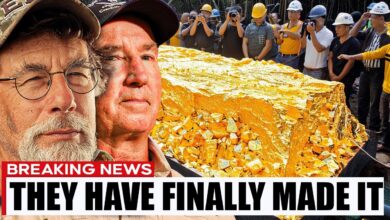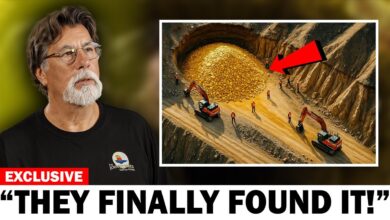The Curse of Oak Island: STRANGEST ITEM EVER DISCOVERED (Season 8) | History
The Curse of Oak Island: STRANGEST ITEM EVER DISCOVERED (Season 8) | History

In the uplands near the northeastern border of the man-made triangle-shaped swamp,
there’s all stones under here, Rick, look, stone, stone, stone.
Rick Lagina and Charles Barkhouse continue working with archaeologists Dr. Aaron Taylor and Miriam Ammerald,
heavy equipment operator Billy Gerhart, and metal detection expert Gary Drayton to uncover more sections of the cobblestone pathway.
“Oh look what you got!”
“Oh, that’s a piece, definitely a piece of pottery.”
“Yeah, yeah, that’s like the bottom of a plate or something though.”
Now, with just a few days left before the first snowfall is expected on Oak Island,
and the end of major search activities that they will be able to conduct this year,
it is their hope to determine just where the pathway leads and if any valuable objects can be found hidden within it.
“Hey guys.”
“Hey Erin, how’s it going?”
“You tell us.”
“Here’s what we’ve come up.”
“Holy cow, that just came out of… I dug that out right there, okay.”
“So we have the annular ware British ceramic, comes in 1751.
Then we have the creamware, which comes in 1762-63.
So you have such a different variety.”
The question was raised: Will this road lead us to X?
Possible treasure?
Sure, it’s a possibility, but the hope is that we’ll find some artifacts which can be tested
to create a proper timeline and an understanding of why that feature was built.
“But this certainly is a very unique feature, and we have to follow it to the end.”
“Alright, this is great, you guys. I’ll go get a bag for you, but in the meantime,
you just keep putting your artifacts in this little dustpan, okay? And just keep going,
and I will be back shortly, okay?”
“It definitely seems to be more rock back here, yeah.”
“Oh, oh, oh, oh, oh, oh, oh, oh, oh, what do you got?”
“That is something different there, round, look at that.”
“Yeah, what is it, metal?”
“What is it?”
“Oh, I can see it. Round, yeah.”
“What is that?”
“That is like nothing I’ve ever seen before. Heavy too. It’s definitely different.”
“Oh, God, that’s cool.”
“The coloration on it is strange. There’s some markings on the end too, is it?”
“Look at… you see that right there?”
“Yeah, some kind of a number, isn’t it?”
“Then is that 55? I see a five.”
“Do you think it’s some kind of a weight or something?”
A possible metal weight found along the stone pathway bordering the swamp.
What might have been its purpose? Could it be a tool of some kind?
Like the possible stonemason’s T-square discovered two weeks ago near this area,
and which was carbon dated to as early as 1632?
“That, without question, is the strangest thing I’ve seen come out of the ground.”
“It does look like a number on that side right there.”
“That is a prime candidate for XRF.”
“Oh, yeah, for sure.”
X-ray fluorescence analysis, or XRF, is a process which employs non-destructive radiation in order to determine an object’s chemical composition.
It will also identify whether or not the metal used to make the artifact is of a precious nature.
[Music]
“This is a significantly interesting area. Anyway, see what else you can find, okay?”
“You.”







